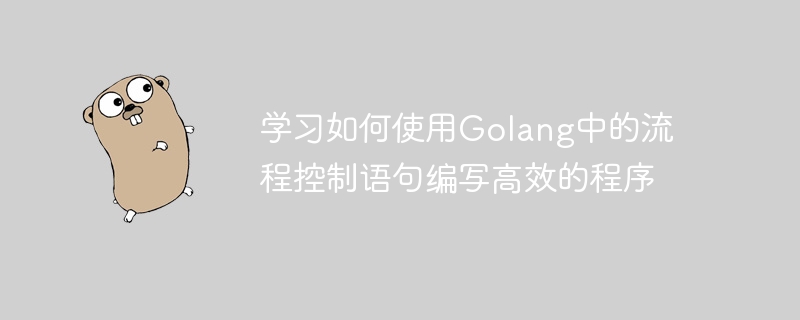Home >Backend Development >Golang >Learn how to write efficient programs using flow control statements in Golang
Learn how to write efficient programs using flow control statements in Golang
- PHPzOriginal
- 2023-12-23 11:23:311089browse

Learning how to use flow control statements in Golang to write efficient programs requires specific code examples
Golang is a powerful and efficient programming language. Compared with Like other languages, it provides some unique and powerful flow control statements, allowing us to write more efficient programs. In this article, we'll explore some common flow control statements and provide some practical code examples.
- Conditional statements
In Golang, conditional statements mainly come in two forms: if statement and switch statement.
The basic format of the if statement is as follows:
if condition {
// 执行语句块
} else {
// 执行语句块
}The sample code is as follows:
package main
import "fmt"
func main() {
x := 10
if x > 5 {
fmt.Println("x 大于 5")
} else {
fmt.Println("x 不大于 5")
}
}The basic format of the switch statement is as follows:
switch variable {
case value1:
// 执行语句块
case value2:
// 执行语句块
default:
// 执行语句块
}The sample code is as follows:
package main
import "fmt"
func main() {
x := 2
switch x {
case 1:
fmt.Println("x 等于 1")
case 2:
fmt.Println("x 等于 2")
default:
fmt.Println("x 不等于 1 或 2")
}
}- Loop statements
In Golang, loop statements mainly come in two forms: for statement and range statement.
The basic format of the for statement is as follows:
for initialization; condition; increment/decrement {
// 执行语句块
}The sample code is as follows:
package main
import "fmt"
func main() {
for i := 1; i <= 10; i++ {
fmt.Println(i)
}
}The range statement can be used to traverse elements in data structures such as arrays, slices, and maps. The sample code is as follows:
package main
import "fmt"
func main() {
numbers := []int{1, 2, 3, 4, 5}
for index, value := range numbers {
fmt.Println("索引:", index, " 值:", value)
}
}- Jump statement
In Golang, there are three main types of jump statements: break statement, continue statement, and goto statement.
The break statement is used to exit the loop. The sample code is as follows:
package main
import "fmt"
func main() {
for i := 1; i <= 10; i++ {
if i > 5 {
break
}
fmt.Println(i)
}
}The continue statement is used to skip the remaining statements of the current loop and enter the next loop. The sample code is as follows:
package main
import "fmt"
func main() {
for i := 1; i <= 10; i++ {
if i%2 == 0 {
continue
}
fmt.Println(i)
}
}The goto statement is used to unconditionally transfer to the specified label. The sample code is as follows:
package main
import "fmt"
func main() {
i := 1
LOOP:
if i <= 10 {
fmt.Println(i)
i++
goto LOOP
}
}When using the goto statement, care should be taken to avoid excessive use to avoid confusing the program flow.
Through the above example code, I believe readers have a certain understanding of how to use flow control statements in Golang to write efficient programs. In actual development, the flexible use of these statements will greatly improve the efficiency and readability of the program. Whether you choose appropriate conditional statements, loop statements, or use jump statements, they need to be used in a targeted manner according to the needs of specific problems. I hope this article can be helpful to you, thank you for reading!
The above is the detailed content of Learn how to write efficient programs using flow control statements in Golang. For more information, please follow other related articles on the PHP Chinese website!

